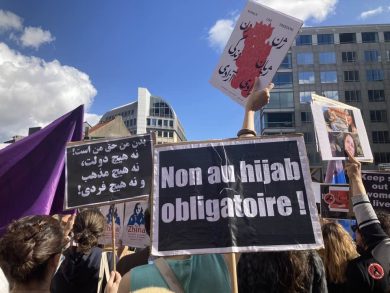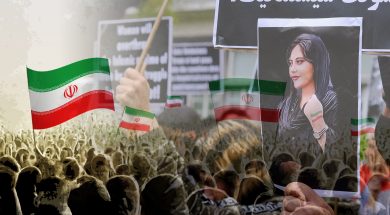In Iran, where public expression is heavily censored and dissent is criminalized, art has become one of the most powerful tools of protest and resistance—especially for women. From music and poetry to graffiti, film, and performance art, Iranian women are transforming creativity into defiance. Against the backdrop of systematic repression by the Islamic Republic and the IRGC (Islamic Revolutionary Guard Corps), women artists and activists are reclaiming public space, challenging gender norms, and envisioning a free and equal future.
This analysis explores how artistic expression empowers Iranian women, how the regime suppresses creativity, and how women are using artistic resistance to fuel movements such as Women, Life, Freedom. Through their creativity, Iranian women are not only resisting oppression—they are redefining national identity, freedom, and feminism in the Middle East.
1. The Cultural Battleground: Art as Political Expression in Iran
1.1 Historical Context of Artistic Censorship
Since the 1979 Islamic Revolution, Iran has operated under strict religious and political controls over cultural life. Music, cinema, literature, fashion, and visual arts are all subjected to:
• Censorship by the Ministry of Culture and Islamic Guidance.
• Surveillance and persecution of artists by security forces, including the IRGC.
• Criminalization of artistic works deemed “immoral,” “anti-Islamic,” or “politically subversive.”
Despite these obstacles, art has remained a vital form of survival, communication, and protest—especially among Iranian women, who face additional restrictions in expressing themselves publicly.
2. Art as Resistance: Women’s Creative Defiance
2.1 The Power of the Visual: Hijab and Body as Canvas
The compulsory hijab is one of the most visible symbols of gender control in Iran. Women artists have used photography, painting, performance art, and fashion to challenge this control:
• Masih Alinejad’s #MyStealthyFreedom campaign encouraged women to share hijab-free images, turning social media into a digital protest gallery.
• Artists like Shirin Neshat, although working in exile, use photography and video to explore the contradictions and power dynamics around women’s bodies, voice, and agency in Iranian society.
The body, especially the female body, becomes a site of rebellion, transforming acts like removing the hijab or dancing in public into powerful statements of autonomy.
2.2 Street Art and Graffiti
Though illegal, graffiti and mural art have flourished as tools of protest. During the 2022 Mahsa Amini protests, walls across Tehran and other cities were adorned with:
• Slogans like “Women, Life, Freedom”.
• Portraits of killed protesters, especially women and girls.
• Symbolic images like burning hijabs, eyes crying blood, and bound mouths.
This anonymous visual resistance plays a vital role in maintaining protest momentum, especially when traditional media and protest gatherings are suppressed.
3. The Role of Poetry, Music, and Performance
3.1 Poetry as Political Testimony
Poetry holds a special place in Iranian culture. From classical figures like Hafez and Rumi to modern voices like Forough Farrokhzad, poetry is a means of both spiritual insight and social critique. In today’s resistance, women write poems that:
• Chronicle the pain of imprisonment and state violence.
• Express collective mourning and hope.
• Honor the martyrs of the revolution, especially women like Nika Shakarami and Hadis Najafi.
These poems, often banned inside Iran, are shared globally through social media, protests, and diasporic art exhibitions.
3.2 Music and Dance: Joy as Rebellion
Women are legally forbidden to sing solo or dance publicly in Iran. But through underground music videos, social media challenges, and protest flash mobs, they resist:
• Anonymous singers perform feminist anthems online, risking arrest.
• Young women dance in the streets and post videos, turning joy into protest.
• Protest songs like “Baraye” by Shervin Hajipour (based on social media posts) became the anthem of the Mahsa Amini movement, later winning a Grammy.
These acts show that artistic joy is a form of resistance when repression seeks to destroy beauty and autonomy.
4. Digital Art and the Cyber Battlefront
With state-controlled media and surveillance of public spaces, many women artists have moved their creativity online. Instagram, Telegram, and Twitter have become digital canvases and protest platforms:
• Illustrators and cartoonists post political art anonymously.
• Photographers document protests and daily acts of resistance.
• Activist filmmakers release short films exposing abuse by the IRGC and morality police.
The IRGC, in turn, uses cyber surveillance, hacking, and arrests to suppress these digital voices. Yet the creativity of Iranian women continues to adapt and evolve, using VPNs, code language, and global platforms to stay one step ahead.
5. Creativity Behind Bars: Prison Letters and Art
Women imprisoned for activism and expression continue to create art—writing poetry, drawing, or documenting their experiences. These works often make their way to the outside world through:
• Smuggled letters and drawings.
• Reports by family members or human rights organizations.
• International exhibitions featuring prison art by Iranian women.
Narges Mohammadi, Nobel Peace Prize laureate, has written extensively from prison about torture, solitary confinement, and the strength of women political prisoners. Her words have become both testimony and art, turning silence into voice.
6. Exiled Artists: Keeping the Flame Alive Abroad
Many Iranian women artists have been forced into exile due to persecution, yet they continue their fight through:
• International exhibitions and film festivals.
• Diaspora theater, music, and poetry.
• Solidarity events and campaigns for political prisoners.
Artists like Shohreh Aghdashloo, Shirin Neshat, and Golshifteh Farahani have used their international platforms to bring attention to gender apartheid and the courage of women inside Iran.
7. The Regime’s War on Creativity
The IRGC and other arms of the Islamic Republic view artistic freedom as a threat because:
• It challenges the official narrative of morality and control.
• It mobilizes emotions and imagination against oppression.
• It builds solidarity across generations, genders, and borders.
In response, the regime:
• Shuts down exhibitions and arrests artists.
• Blocks internet access and censors online content.
• Labels art as “Western corruption” or “Zionist propaganda.”
But despite these tactics, creativity in Iran has proven unkillable.
8. Why Art Matters in the Women, Life, Freedom Movement
8.1 Art Builds Identity and Memory
Iranian women use art not just to protest, but to:
• Preserve the memory of victims and events.
• Shape a collective identity rooted in resistance.
• Reclaim narratives stolen by propaganda and fear.
8.2 Art Is Accessible Protest
In a regime where organizing is dangerous, art provides an alternative space for protest that can be:
• Anonymous.
• Digital and shareable.
• Symbolic and emotional—connecting deeply with people.
9. Global Solidarity Through Creative Expression
International artists, musicians, and activists have joined Iranian women by:
• Creating art inspired by the “Women, Life, Freedom” movement.
• Collaborating with Iranian women in exile.
• Hosting global exhibitions, concerts, and performances in solidarity.
This cultural bridge-building is vital. It ensures that Iranian women’s resistance is not isolated—but rather part of a global wave of feminist freedom movements.
Conclusion: Creativity is a Revolutionary Force
Art is not a luxury in times of oppression—it is a weapon, a lifeline, and a form of freedom.
In Iran, women’s creativity has become a revolutionary force, confronting not only censorship and dictatorship but the entire structure of patriarchal control.
From protest murals to whispered poetry, from illegal music videos to underground theater, Iranian women’s art is more than expression—it is resistance, memory, and hope.
Join Our Newsletter!
Stay informed with the latest updates, news, and ways to take action in the fight for justice and global security. Sign up now to get updates delivered straight to your inbox!





